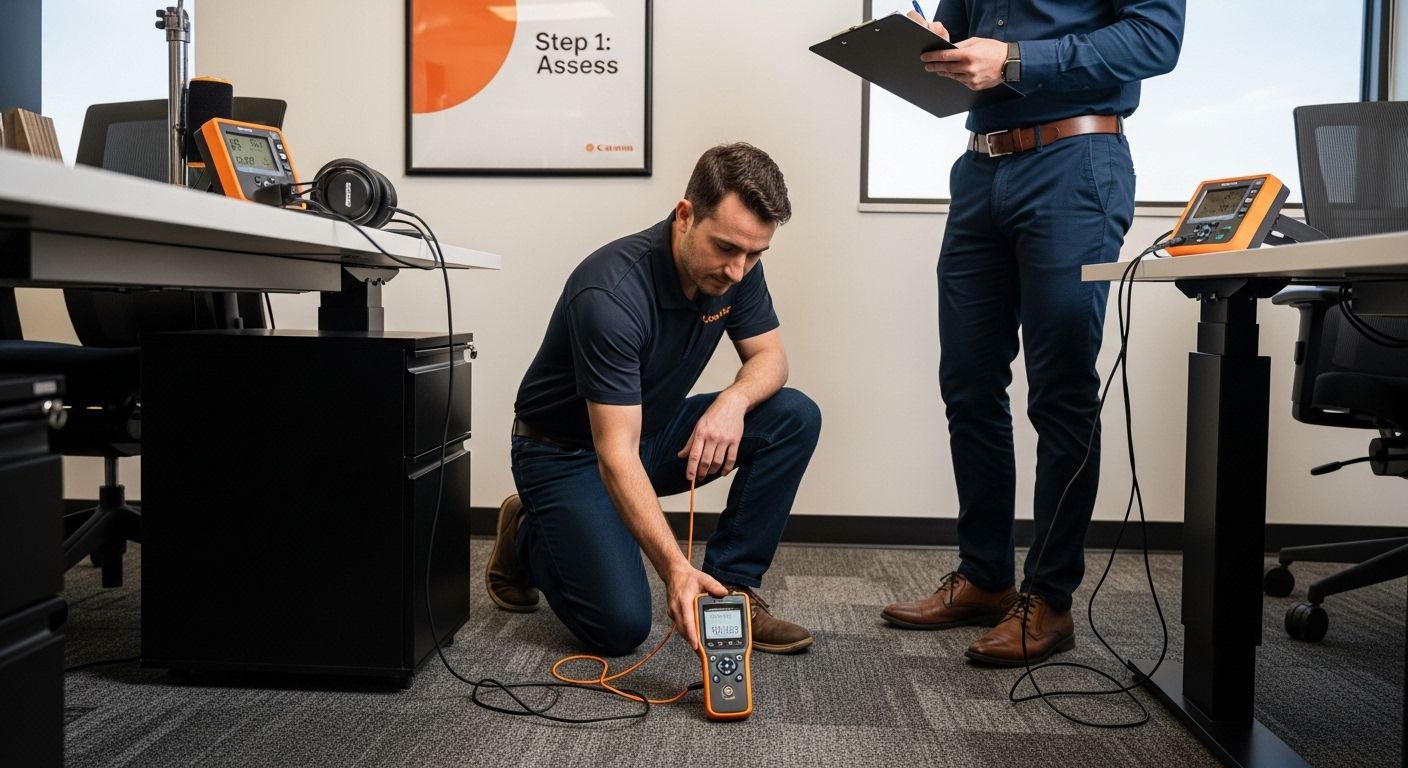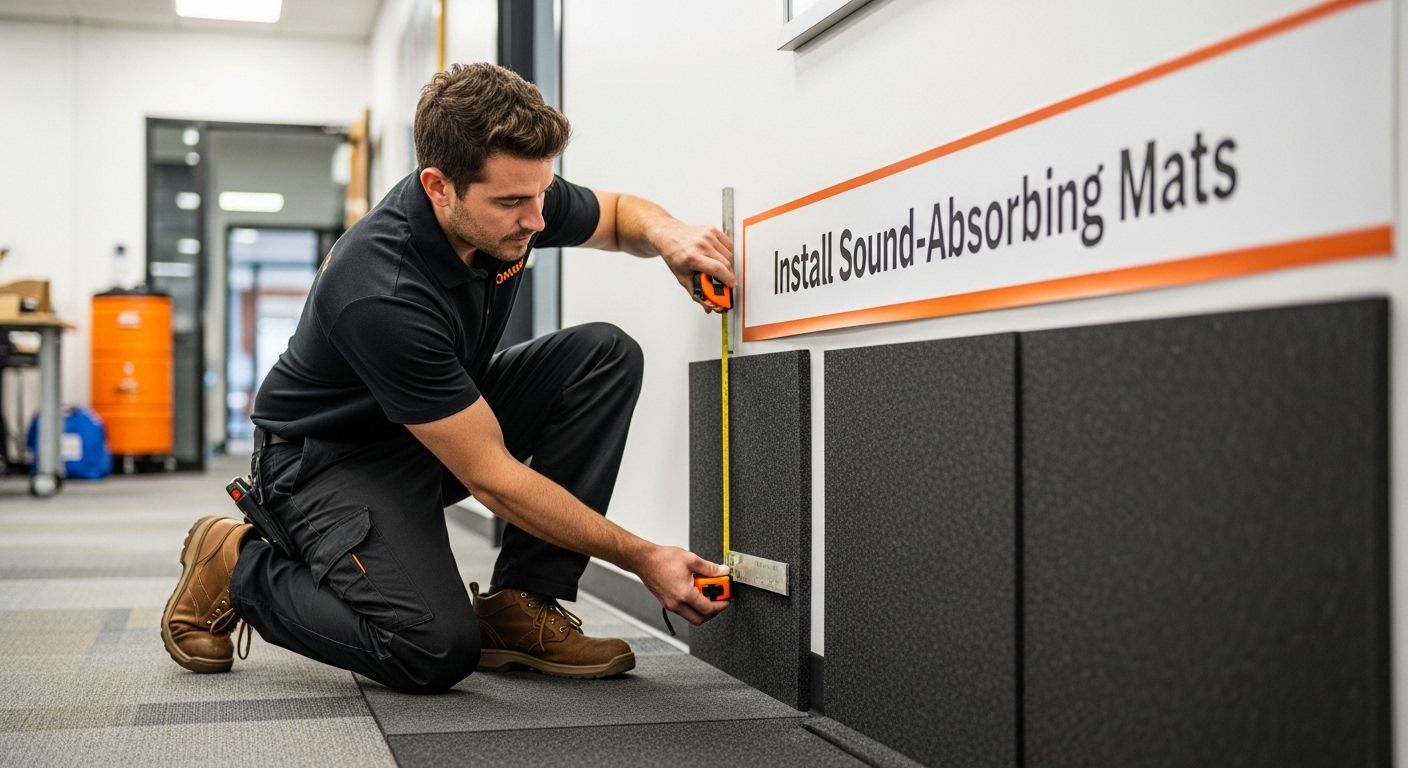Floor noise is a stubborn problem in busy commercial spaces. Heavy rolling equipment and high foot traffic can push noise to uncomfortable levels and create disruptive work environments. Most people assume a few rugs or random mats will solve it. Yet some of the most effective fixes involve precise measurement and materials chosen for your specific acoustic challenges. The difference between ordinary and peaceful might be just a few overlooked details.

Table of Contents
- Step 1: Assess Your Current Floor Noise Situation
- Step 2: Identify Appropriate Noise Reduction Materials
- Step 3: Install Sound-Absorbing Mats Effectively
- Step 4: Implement Additional Soundproofing Techniques
- Step 5: Test and Verify Noise Reduction Effectiveness
Quick Summary
| Key Point | Explanation |
|---|---|
| 1. Assess your noise environment systematically | Conduct a thorough assessment of noise sources and intensity to establish a baseline for reduction efforts. |
| 2. Choose effective noise reduction materials | Select materials like cork or rubber that specifically absorb sound and suit your commercial space’s needs. |
| 3. Install mats with precision and care | Properly prepare floors and follow installation guidelines to ensure sound-absorbing mats effectively reduce noise. |
| 4. Implement multi-layered soundproofing techniques | Address sound transmission through walls and ceilings by adding density and using acoustic panels or barriers. |
| 5. Regularly measure and verify noise levels | Continuously assess decibel levels post-installation to ensure ongoing effectiveness of noise reduction strategies. |
Step 1: Assess Your Current Floor Noise Situation
Reducing floor noise in commercial spaces begins with a comprehensive understanding of your current acoustic environment. Before implementing any noise reduction strategies, you must conduct a thorough assessment that pinpoints the specific sources, characteristics, and intensity of floor noise in your workspace.
Starting your assessment requires precision and systematic observation. Begin by walking through your commercial space during different times of day, paying close attention to areas with high foot traffic, equipment movement, or frequent activities. Listen carefully to the sounds generated by different floor surfaces and identify where noise levels seem most pronounced. Some key areas to scrutinise include entryways, corridors, open workspaces, and zones with heavy rolling equipment.
To quantify your noise levels, utilise a professional sound level meter capable of measuring decibel ranges relevant to floor interactions. According to the ASHRAE Handbook, precise measurement involves recording sound pressure levels at multiple locations within your space. These measurements will provide a baseline understanding of your current noise environment and help you develop targeted noise reduction strategies.
Consider documenting your findings through a structured noise assessment report. Your report should include:
- Specific locations with highest noise generation
- Decibel measurements at different times and zones
- Types of floor surfaces contributing to noise
- Primary sources of sound transmission
- Potential impact on workplace productivity and employee comfort
Remember that floor noise assessment is not a one-time event but an ongoing process. Regular monitoring allows you to track improvements and adjust your noise reduction strategies accordingly. By establishing a comprehensive baseline, you create a solid foundation for implementing effective acoustic management techniques in your commercial environment.

Step 2: Identify Appropriate Noise Reduction Materials
Selecting the right noise reduction materials is a critical step in managing floor noise in commercial spaces. Your choice of materials can dramatically transform the acoustic environment, reducing sound transmission and creating a more comfortable workspace. The goal is to strategically select materials that absorb, dampen, and block unwanted noise generated by foot traffic, equipment movement, and other daily activities.
Your material selection process should begin with understanding the specific characteristics of your commercial space. Different environments require tailored acoustic solutions. Industrial settings with heavy machinery will need more robust noise reduction strategies compared to open-plan offices or retail spaces. Consider factors such as floor traffic volume, types of activities performed, existing floor surfaces, and the overall acoustic profile you discovered during your initial assessment.
Research from the U.S. General Services Administration highlights several effective noise reduction materials that can be integrated into commercial spaces. Resilient underlayments like cork, rubber, and specialized acoustic foam provide excellent sound absorption properties. These materials work by creating a cushioning layer that interrupts sound vibrations before they can travel through the floor structure. For areas with high foot traffic or rolling equipment, consider materials with high density and compression resistance.
When evaluating noise reduction materials, prioritise those with proven performance metrics. Look for materials with:
- Proven sound absorption coefficients
- Durability under consistent commercial use
- Compatibility with existing floor surfaces
- Ease of installation and maintenance
- Compliance with building and safety regulations
Remember that material selection is not just about sound reduction but also about maintaining the functionality and aesthetic of your commercial space. Some materials offer additional benefits like thermal insulation, slip resistance, or enhanced comfort for employees. By carefully matching noise reduction materials to your specific environment, you create a more pleasant and productive workspace that effectively manages acoustic challenges.
Below is a comparison table of common noise reduction materials highlighted in the article, including their characteristics and best use cases. This helps you select the most suitable option for your commercial space.
| Material Type | Key Characteristics | Best Used In |
|---|---|---|
| Cork Underlayments | High sound absorption, eco-friendly | Offices, retail spaces |
| Rubber Underlayments | Excellent vibration dampening, durable | Industrial areas, corridors |
| Acoustic Foam | Lightweight, easy installation | Meeting rooms, ceilings |
| Specialised Mats | High density, slip-resistant | Zones with rolling equipment |
| Composite Underlays | Layered for enhanced performance | Multi-purpose commercial areas |
Step 3: Install Sound-Absorbing Mats Effectively
Installing sound-absorbing mats is a precise process that requires careful planning and execution to maximise noise reduction in commercial spaces. The goal is to create a strategic acoustic barrier that minimises sound transmission while maintaining the functional integrity of your workspace. Proper installation goes far beyond simply laying down a mat it involves understanding the specific requirements of your environment and implementing a systematic approach.
Begin by thoroughly preparing the existing floor surface. Clean the area completely, ensuring that all dust, debris, and uneven surfaces are addressed before mat installation. This preparation is crucial for achieving optimal mat performance and longevity. Measure the space precisely, accounting for any obstacles or unique architectural features that might impact mat placement. Consider using professional measuring tools to guarantee accuracy and minimise waste.
Research published in the Journal of Korean Institute of Architectural Sustainable Environment and Building Systems suggests that mat thickness plays a critical role in noise reduction. Choose mats with appropriate thickness for your specific environment, typically ranging from 10 to 20 millimetres for most commercial applications. When positioning the mats, ensure complete coverage of high-traffic areas and zones with significant noise generation.
Proper mat installation involves several key considerations:
- Ensure tight, seamless connections between mat sections
- Avoid gaps or overlapping edges that could compromise noise reduction
- Use appropriate adhesives or fixing methods recommended by the manufacturer
- Check for uniform contact with the underlying surface
After installation, conduct a comprehensive noise assessment to verify the effectiveness of your sound-absorbing mats. Walk across the surface, test with rolling equipment, and measure sound levels to confirm that the mats are performing as expected. Remember that mat installation is not a one-time solution but an ongoing process of maintenance and periodic reassessment. Regular inspection and timely replacement of worn mats will ensure continued noise reduction in your commercial space.
Use this checklist table to ensure that sound-absorbing mats are installed correctly and that all key quality checks are addressed for ongoing effectiveness.
| Installation Step | Verification Criteria | Status |
|---|---|---|
| Floor surface cleaned and levelled | No dust, debris, or unevenness remains | |
| Area measured and marked | Dimensions checked and obstacles noted | |
| Appropriate mat thickness selected | Thickness matches requirements for commercial use | |
| Mats fitted without gaps or overlap | Tight, seamless joints between sections | |
| Correct adhesive/fixings used | Manufacturer-recommended products applied | |
| Uniform contact with floor/base | No loose sections; mat lays flat throughout area | |
| Post-installation noise tested | Decibel reduction confirmed by measurement |

Step 4: Implement Additional Soundproofing Techniques
Beyond sound-absorbing mats, comprehensive noise reduction requires a multi-layered approach to soundproofing your commercial space. This step focuses on integrating advanced techniques that work synergistically to minimise sound transmission and create a more acoustically controlled environment. Think of these techniques as creating an acoustic shield that protects your workspace from unwanted noise.
Strategic soundproofing is about addressing noise at multiple points of transmission. Start by examining the structural elements of your space, paying close attention to potential sound leak points such as walls, windows, and connecting areas. Walls represent a significant pathway for sound transmission, so consider adding mass and density to existing structures. This might involve installing additional layers of sound-dampening materials, using specialised acoustic panels, or applying sound-blocking compounds to existing wall surfaces.
According to the Federal Highway Administration, enhancing structural sound transmission involves several key strategies. Create acoustic separation by using resilient channels that decouple wall surfaces, effectively interrupting sound vibration paths. This technique prevents sound from travelling directly through structural elements, significantly reducing noise transfer between different areas of your commercial space.
Consider these critical soundproofing elements:
- Install acoustic ceiling tiles with high sound absorption ratings
- Use weatherstripping and door sweeps to seal potential sound gaps
- Apply sound-dampening compound to wall joints and electrical outlets
- Incorporate soft furnishings that naturally absorb sound waves
Verify the effectiveness of your soundproofing efforts through comprehensive acoustic testing. Conduct sound level measurements before and after implementation to quantify improvements. Remember that soundproofing is an iterative process requiring ongoing assessment and adjustment. By systematically addressing sound transmission pathways, you create a more controlled acoustic environment that supports productivity and comfort in your commercial space.
Step 5: Test and Verify Noise Reduction Effectiveness
Verifying the success of your noise reduction efforts is a critical final step that transforms theoretical soundproofing into measurable acoustic improvement. This stage is about empirical validation, ensuring that the techniques and materials you have implemented actually deliver the desired noise reduction in your commercial space.
Precision is paramount when conducting acoustic performance testing. Begin by investing in a professional-grade sound level meter capable of capturing decibel readings across different frequencies. These devices provide objective measurements that go beyond subjective perceptions of noise. Conduct your testing during various times of day to capture the full range of acoustic challenges your space experiences, including peak activity periods and quieter moments.
According to the ASTM International standard testing methods, comprehensive noise verification involves multiple measurement points and scenarios. Create a systematic testing protocol that includes measuring sound levels before and after implementing noise reduction techniques. Walk through different areas of the space, simulate typical workplace activities, and record decibel readings at consistent distances and heights. Pay special attention to high-traffic zones, areas near machinery, and spaces with potential sound transmission pathways.
During your verification process, focus on these key assessment criteria:
- Reduction in overall decibel levels compared to initial measurements
- Consistency of noise reduction across different space zones
- Improvement in speech intelligibility and acoustic comfort
- Maintenance of workplace functionality alongside noise reduction
Document your findings meticulously, creating a comprehensive report that includes before and after sound level graphs, specific location measurements, and qualitative observations from workplace occupants. Remember that noise reduction is an ongoing process. Schedule periodic acoustic assessments to ensure continued effectiveness and make incremental improvements as your commercial space evolves. By adopting a data-driven approach to noise management, you create an environment that supports productivity, comfort, and overall workplace well-being.
Transform Your Commercial Space with Custom Acoustic Matting Solutions
If you are struggling with persistent floor noise that hampers productivity and disrupts comfort, you are not alone. Your step-by-step noise assessment might have revealed high-traffic zones and problematic surfaces that fuel distractions. Addressing these issues is vital for a healthier, quieter workplace. At Mats4U, we understand the importance of tailored sound-absorbing mats and floor coverings that target specific noise challenges highlighted in your recent review, such as effective underlayments, seamless installations and ongoing durability.

Take control of your commercial sound environment today. Discover custom mat options for every industry and floor type, from resilient rubber mats to precision-fit acoustic solutions. Whether your space needs improved comfort in corridors, heavy-duty equipment areas or branded noise control, our fully customisable matting range empowers you to choose noise reduction that fits your operational needs. Do not let disruptive noise linger — visit Mats4U now to build your acoustic strategy and support long-lasting productivity.
Frequently Asked Questions
What are the key steps to assess floor noise in a commercial space?
To assess floor noise, conduct a thorough walkthrough of your space at different times, paying attention to areas with high foot traffic and noise. Use a professional sound level meter to quantify noise levels, and document your findings to identify specific sources and characteristics of the noise.
How can I choose the right noise reduction materials for my commercial space?
Selecting the right noise reduction materials involves understanding your space’s specific needs, including traffic volume and noise sources. Consider resilient underlayments like cork or rubber, and prioritise materials with proven sound absorption coefficients and compatibility with existing flooring.
What is the importance of sound-absorbing mats in reducing floor noise?
Sound-absorbing mats play a crucial role in mitigating floor noise by creating a cushioning layer that interrupts sound vibrations. Properly installed mats can significantly reduce noise from foot traffic and equipment, contributing to a more comfortable acoustic environment.
How can I effectively test the noise reduction effectiveness after implementing soundproofing techniques?
To test the effectiveness of your noise reduction efforts, use a professional-grade sound level meter to measure decibel levels before and after implementing the techniques. Conduct tests during various times of day and across different areas to ensure accurate assessment of noise reduction and overall acoustic performance.









